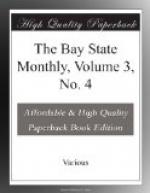It was of a most attractive looking young lady of, perhaps, twenty-two years.
“Ah! I see that my suggestion is not needed,” I said, holding the picture at arm’s length to get a better general impression. “Is she yours?”
He flushed a little at so direct a question, as he answered evasively:—
“She is a very true friend of mine.”
“But she is more than that. Now, tell me, Gault, when is your honeymoon to begin?”
“That is more than I can tell,” he replied, slowly returning the photograph to his pocket book.
“You must not wait to get rich,” I observed. “It is when a man is working for success that he most needs the sympathy and help of a good wife.”
“I know that,” replied my friend; “but I am in a peculiar position. Some day I will tell you all.”
I saw that he was growing nervous, and changed the subject of conversation.
Returning from the post office that afternoon to the old farm house, I stopped for a little chat with Deacon Thompson, my good natured host, who was mending his orchard fence; for the well loaded boughs of apples, just beginning to assume their various tinges of red, yellow, or russet, offered a strong temptation to the cattle in the adjoining pasture. Incidentally I inquired regarding an old excavation which I had noticed on the hill near an unfrequented road. This excavation had apparently once served for a cellar, although most of the stones had been removed, and the sheep easily ran down its now sloping and grassy sides. In close proximity was a deep well, over the top of which had been placed a huge, flat stone. Overshadowing both cellar and well were three ancient elms, storm-beaten and lightning-cleft, but still standing as if to guard the very solitude which was unbroken save by the tinkling bell, which told whither the farmer’s flock was straying. From Mr. Thompson I learned the history connected with this scene.
Twenty years before he was born, his father’s folks saw, one morning in March, a smoke curling above the tops of the elms which were just visible over the brow of the hill. Quickly going to the scene, they found the house burned to the ground. The occupants were an old man, named Peter Colburn, and his wife; and they, together with a traveller, who had obtained lodging there for the night, were all burned with the house. The stranger’s horse and saddle were found in the barn, some little distance from the house, but there was no clew to his identity. There were only a few people then who had settled in this bleak region, and there was no funeral other than the assembling of a half dozen together, who dug a grave within fifty feet from the elms, and there laid the charred remains of the unfortunate victims. I had seen a small, rough, unlettered stone standing there, but did not before know its meaning.
The next day I related the bit of tragic history to Christopher Gault, and we strolled over the hill to its scene.




